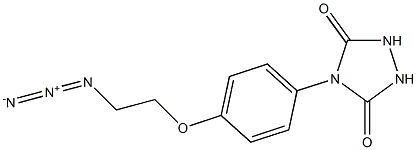4-(4-(2-Azidoethoxy)phenyl)-1,2,4-triazolidine-3,5-dione

|
- $172.8 - $277
- Product name: 4-(4-(2-Azidoethoxy)phenyl)-1,2,4-triazolidine-3,5-dione
- CAS: 1313211-52-7
- MF: C10H10N6O3
- MW: 262.2248
- EINECS:
- MDL Number:MFCD25976544
- Synonyms:4-(4-(2-Azidoethoxy)phenyl)-1,2,4-triazolidine-3,5-dione;PTAD-Azide;PTAD-Azide AldrichCPR;PTAD-Azide 95%
2 prices
Selected condition:
Brand
- Sigma-Aldrich
Package
- 50mg
- ManufacturerSigma-Aldrich
- Product numberALD00344
- Product descriptionPTAD-Azide 95%
- Packaging50mg
- Price$172.8
- Updated2024-03-01
- Buy
- ManufacturerSigma-Aldrich
- Product numberT511552
- Product descriptionPTAD-Azide Aldrich
- Packaging50mg
- Price$277
- Updated2024-03-01
- Buy
| Manufacturer | Product number | Product description | Packaging | Price | Updated | Buy |
|---|---|---|---|---|---|---|
| Sigma-Aldrich | ALD00344 | PTAD-Azide 95% | 50mg | $172.8 | 2024-03-01 | Buy |
| Sigma-Aldrich | T511552 | PTAD-Azide Aldrich | 50mg | $277 | 2024-03-01 | Buy |
Properties
storage temp. :2-8°C
form :powder or crystals
form :powder or crystals
Safety Information
| Symbol(GHS): | ||||||||
|---|---|---|---|---|---|---|---|---|
| Signal word: | ||||||||
| Hazard statements: |
|
|||||||
| Precautionary statements: |
|





